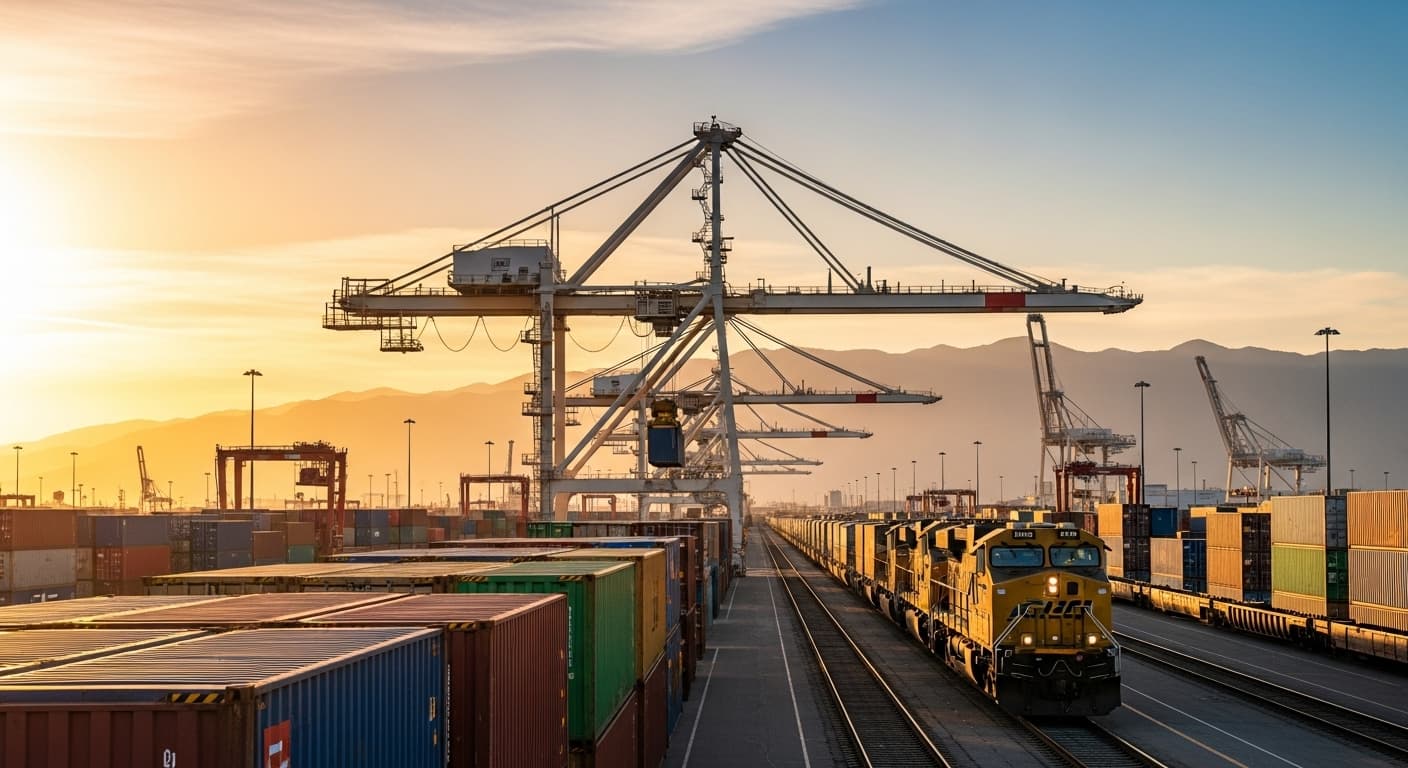
Executive Summary
The less-than-truckload (LTL) freight market continues adapting to significant structural changes following major industry consolidation events. Capacity adjustments, evolving rate structures, and shifting competitive dynamics create both challenges and opportunities for shippers managing LTL transportation requirements. Understanding current market conditions, pricing trends, and strategic considerations enables effective navigation of the evolving LTL landscape.
Understanding LTL Market Evolution: Capacity, Rates, and Strategic Positioning
(了解零担市场演变:运力、费率与战略定位)
1 · The LTL Market Landscape
The less-than-truckload freight sector serves a critical role in North American supply chains, handling shipments too large for parcel services but not requiring dedicated truckload capacity. Understanding current market structure and dynamics provides essential context for strategic decision-making.
Market Structure and Characteristics
LTL Service Model: Less-than-truckload carriers consolidate multiple shipments from different customers onto single trailers, creating economies of scale that make smaller shipments economically viable. This hub-and-spoke network model requires sophisticated terminal operations, cross-docking capabilities, and complex routing optimization.
Market Segments: The LTL market serves diverse customer segments with varying requirements:
Regional Carriers: Regional LTL carriers focus on specific geographic areas, typically offering one- or two-day service within their operating territories. These carriers often provide competitive pricing and strong service quality within their coverage areas, though geographic limitations constrain their utility for longer-haul movements.
National Carriers: National LTL carriers maintain extensive networks covering the United States and often Canada and Mexico. These carriers can handle shipments requiring longer transit distances and offer comprehensive geographic coverage, though pricing may be higher than regional alternatives for short-haul movements within specific regions.
Specialized Carriers: Some LTL carriers focus on specific commodity types, industries, or service requirements. Specializations might include temperature-controlled freight, hazardous materials, high-value goods, or time-critical deliveries requiring guaranteed service.
Industry Consolidation Impact
Market Structure Changes: The LTL industry has experienced significant consolidation over recent years, with major carriers acquiring smaller competitors and some carriers exiting the market entirely. These structural changes affect capacity availability, competitive dynamics, and pricing patterns throughout the industry.
Capacity Considerations: Industry consolidation has reduced the number of available carriers in many markets, affecting capacity dynamics particularly during peak demand periods. Understanding capacity availability and carrier alternatives becomes increasingly important for shippers managing transportation requirements.
Service Network Evolution: Carrier consolidation often leads to network rationalization as acquiring carriers integrate acquired operations. Terminal consolidations, route optimizations, and service pattern changes affect transit times and service characteristics for specific lanes and customer segments.
2 · Understanding Rate Trends and Pricing Dynamics
LTL pricing follows complex structures reflecting numerous factors affecting cost and value. Understanding these dynamics helps shippers evaluate pricing and make informed carrier selection decisions.
Producer Price Index Trends
PPI as Market Indicator: The Producer Price Index for LTL transportation services provides insight into broader industry pricing trends. Recent data showing year-over-year increases reflects various cost pressures and market dynamics affecting the sector.
Cost Component Analysis: Multiple cost factors influence LTL pricing trends:
Labor Costs: Driver wages, dock worker compensation, and administrative staff salaries represent substantial portions of LTL operating costs. Competitive labor markets, driver shortages in some regions, and regulatory requirements affecting driver qualification and hours of service all influence labor cost trends.
Fuel Expenses: Diesel fuel costs significantly affect LTL economics, with carriers typically implementing fuel surcharges that adjust based on fuel price movements. Fuel surcharge methodologies vary among carriers, affecting total transportation costs differently depending on specific calculations and adjustment frequencies.
Equipment and Maintenance: Trailer fleets, tractors, material handling equipment, and terminal facilities require substantial capital investment and ongoing maintenance. Equipment costs, including both acquisition and maintenance expenses, influence carrier pricing strategies.
Facility Costs: Terminal leases or ownership costs, utilities, property taxes, and facility maintenance represent significant fixed costs requiring coverage through rate structures. Terminal network optimization affects these costs, with consolidation potentially reducing some expenses while affecting service characteristics.
Rate Structure Components
Understanding LTL Pricing: LTL rates reflect multiple components beyond simple per-pound or per-mile calculations:
Base Rate Calculation: Base rates typically derive from classification, weight, and distance. The National Motor Freight Classification (NMFC) system assigns classes to different commodities based on density, handling characteristics, liability, and stowability. Higher classes generally result in higher rates for equivalent weights and distances.
Deficit Weight Charges: Most carriers establish minimum charges based on assumed freight density. Shipments below certain weight thresholds for their size incur deficit weight charges, ensuring adequate revenue for space-consuming but lightweight freight.
Accessorial Charges: Numerous accessorial charges may apply for specific services or circumstances:
- Liftgate service for locations without loading docks
- Inside delivery beyond the carrier’s loading dock or tailgate
- Residential delivery to non-commercial locations
- Limited access for locations with restricted access or special requirements
- Notification services for appointment scheduling and delivery coordination
- Reweigh and reclassification fees if actual characteristics differ from rated specifications
Fuel Surcharges: Fuel surcharges adjust for fuel price fluctuations, typically calculated as percentages of base rates based on current fuel prices compared to baseline levels. Understanding carrier-specific fuel surcharge methodologies helps predict total costs accurately.
Contract versus Tariff Pricing
Pricing Approaches: LTL carriers offer various pricing approaches depending on customer relationships and volume levels:
Tariff Pricing: Published tariffs establish baseline pricing available to all customers. While tariffs provide starting points, most significant-volume shippers negotiate pricing agreements offering better rates than published tariffs.
Contract Pricing: Contract agreements establish customer-specific pricing, typically structured as discounts from published tariffs or as negotiated rates for specific lanes or shipment characteristics. Contract pricing reflects volume commitments, service requirements, and competitive market conditions.
Spot Pricing: Some carriers offer spot pricing for individual shipments, particularly for customers without established contracts. Spot rates may provide competitive pricing for occasional shipments but typically lack the certainty and consistency of contract agreements.
3 · Capacity Considerations and Service Reliability
Capacity availability and service reliability represent critical considerations for shippers evaluating LTL options and developing transportation strategies.
Capacity Dynamics
Understanding Available Capacity: LTL capacity reflects the combination of physical assets (tractors, trailers, terminals) and operational resources (drivers, dock workers, managers) required to provide service. Capacity constraints can emerge from limitations in any of these elements.
Peak Season Pressures: Traditional peak seasons, particularly the fourth quarter preceding holiday retail periods, create capacity pressures as demand increases. Service reliability may decline during peak periods as carriers operate near capacity limits, and pricing may increase through peak season surcharges.
Regional Variations: Capacity availability varies by geographic region and specific lanes. Some markets maintain adequate capacity year-round, while others experience periodic constraints based on local economic conditions, seasonal factors, or carrier network structures.
Equipment Availability: Trailer availability affects carrier ability to accept freight, particularly for less common equipment types like refrigerated trailers or specialized configurations. Understanding carrier equipment fleets and availability helps manage expectations and plan accordingly.
Service Quality Factors
Transit Time Reliability: Transit time consistency affects inventory planning, customer service, and operational efficiency. Carriers maintaining reliable transit times provide greater value than those with unpredictable performance, even if average transit times are similar.
Damage Rates: Freight damage creates direct costs for replacement or repair plus indirect costs from customer dissatisfaction and operational disruption. Carriers with lower damage rates provide better value despite potentially higher base rates.
Claims Processing: When damage does occur, efficient claims processing minimizes financial impact and administrative burden. Carriers with straightforward claims procedures and reasonable processing times reduce total cost of transportation problems.
Communication Capabilities: Effective communication regarding shipment status, potential exceptions, and delivery coordination supports supply chain efficiency. Carriers providing proactive communication and responsive customer service create operational advantages beyond basic transportation functions.
4 · Strategic Considerations for Shippers
Effective LTL strategy requires consideration of multiple factors beyond simple rate comparison, balancing cost, service, and risk across transportation requirements.
Carrier Selection Framework
Evaluating Carrier Options: Comprehensive carrier evaluation considers multiple dimensions of performance and capability:
Geographic Coverage: Carrier network coverage must align with shipping requirements. National carriers provide comprehensive coverage but may not offer optimal pricing or service for all lanes. Regional carriers often excel within their territories but require interline connections or multiple carrier relationships for comprehensive coverage.
Service Capabilities: Different carriers excel in different service areas. Some prioritize speed and reliability for time-sensitive freight, while others optimize cost efficiency for less time-critical shipments. Specialized capabilities for temperature-controlled freight, hazardous materials, or high-value goods vary among carriers.
Technology Integration: Carrier technology capabilities affect operational efficiency and visibility. Electronic data interchange (EDI) integration, application programming interfaces (APIs), web-based shipping tools, and tracking systems vary significantly among carriers, affecting ease of use and information availability.
Financial Stability: Carrier financial health affects service reliability and relationship continuity. While shippers need not perform detailed financial analysis, awareness of carrier financial conditions through industry publications and credit rating services helps assess relationship risk.
Network Strategy Development
Optimizing Carrier Networks: Most shippers benefit from multi-carrier strategies rather than single-carrier dependence:
Primary Carrier Relationships: Primary carriers typically handle the majority of shipment volume, receiving volume commitments in exchange for favorable pricing and service priority. These relationships provide foundation for transportation programs while requiring performance management and relationship maintenance.
Secondary Carrier Options: Secondary carriers provide backup capacity for peak periods, service failures, or lanes where primary carriers lack optimal capabilities. Maintaining active secondary relationships requires some volume allocation even during normal periods to ensure carriers maintain commitment when backup capacity is needed.
Specialized Provider Relationships: Certain requirements may justify relationships with specialized carriers offering unique capabilities. Temperature-controlled freight, hazardous materials, oversized shipments, or other special handling needs may require specialist carrier capabilities.
Geographic Optimization: Different carriers may offer optimal service and pricing in different regions. Strategic carrier selection by lane or region can optimize total transportation performance and cost, though administrative complexity increases with carrier proliferation.
Volume Management and Consolidation
Optimizing Shipment Patterns:
Order Consolidation: Combining multiple orders for the same destination into single shipments improves LTL economics through better freight class utilization and reduced accessorial exposure. However, consolidation must balance transportation savings against potential inventory carrying costs and service time impacts.
Shipment Frequency: Optimal shipment frequency balances transportation costs, inventory carrying costs, and service requirements. More frequent smaller shipments provide inventory flexibility and faster response times but at higher per-unit transportation costs. Less frequent larger shipments reduce transportation costs but increase inventory requirements and response time.
Hub-and-Spoke Strategies: Some shippers implement hub-and-spoke distribution strategies, consolidating shipments to regional hubs for subsequent distribution to final destinations. This approach can optimize transportation costs and service times when appropriately designed for specific network requirements.
5 · Operational Best Practices
Effective LTL management extends beyond strategic carrier selection to include disciplined operational execution supporting efficiency and cost control.
Freight Classification Accuracy
Understanding NMFC Classifications: The National Motor Freight Classification system assigns commodity classifications based on transportation characteristics. Accurate classification ensures appropriate pricing and prevents reclassification charges when carriers inspect freight.
Classification Factors: Freight class reflects four primary factors:
- Density: Weight per cubic foot, with denser freight receiving lower classes
- Stowability: Difficulty of loading freight efficiently with other shipments
- Handling: Ease or difficulty of loading and unloading freight
- Liability: Risk of damage or theft based on freight value and fragility
Avoiding Reclassification: Inaccurate classification results in reclassification charges plus administrative burden. Investing time in accurate initial classification prevents these issues while ensuring correct pricing from the outset.
Packaging and Palletization
Optimizing Freight Characteristics: Proper packaging and palletization affect both freight class and handling efficiency:
Density Optimization: Packaging efficiency directly affects freight density and resulting classification. Eliminating excess packaging material and void space improves density, potentially enabling better freight class assignment and lower costs.
Pallet Selection: Standard pallet sizes (48"x40" being most common) facilitate efficient handling and space utilization in carrier networks. Non-standard pallet sizes may result in additional charges or less efficient space utilization.
Stackability: Stackable freight utilizes trailer space more efficiently than non-stackable items. Clear marking of stackability limitations and proper packaging to support stacking when appropriate optimizes freight characteristics.
Protection Requirements: Adequate packaging protection prevents damage while avoiding excessive materials that reduce density. Balancing protection requirements against space efficiency optimizes both freight integrity and classification.
Documentation Accuracy
Bill of Lading Preparation: Accurate, complete bills of lading facilitate smooth shipment processing and prevent delays or additional charges:
Required Information: Bills of lading must include shipper and consignee names and addresses, complete freight descriptions with proper NMFC classifications and weights, declared value for liability purposes, and any special handling instructions or accessorial service requirements.
Hazardous Materials Documentation: Shipments containing hazardous materials require specific documentation, placarding, and handling procedures. Strict compliance with Department of Transportation regulations ensures legal compliance and safety while preventing service refusals or penalties.
Reference Numbers: Purchase order numbers, delivery appointment references, or other tracking information included on bills of lading facilitate coordination between shippers, consignees, and carriers while supporting exception resolution when needed.
6 · Technology and Visibility Solutions
Modern technology provides capabilities for managing LTL transportation more efficiently and effectively than historical manual processes.
Transportation Management Systems
TMS Capabilities for LTL: Transportation management systems offer various capabilities supporting LTL operations:
Rate Shopping: Automated rate comparison across multiple carriers enables identification of optimal carrier and service selections for specific shipments. Rate shopping considers base rates, accessorial charges, fuel surcharges, and transit times, providing comprehensive cost and service comparisons.
Shipment Documentation: Electronic bill of lading generation, label printing, and shipping document creation streamline shipment preparation while ensuring consistency and accuracy. Integration with order management and warehouse systems further improves efficiency.
Tender Management: Electronic tendering sends shipment tenders to carriers automatically, receives acceptance confirmations, and manages the tender process without manual intervention. This automation accelerates processing and improves accuracy.
Performance Analytics: Historical shipment data analysis identifies performance trends, cost patterns, and improvement opportunities. Analytics capabilities support strategic planning, carrier evaluation, and operational optimization.
Tracking and Visibility
Shipment Status Information: Real-time shipment tracking provides visibility throughout the transportation process:
Automated Status Updates: Carriers provide automated status updates as shipments reach key milestones: pickup, departure from origin terminal, arrival at destination terminal, out for delivery, and final delivery confirmation. These updates enable proactive exception management and customer communication.
Exception Alerts: Automated alerts notify relevant parties when shipments deviate from expected patterns, such as missed pickups, delayed arrivals, or delivery issues. Early exception notification enables faster problem resolution and improved customer service.
Proof of Delivery: Electronic proof of delivery documentation, including delivery times, recipient signatures, and photographs when needed, provides confirmation and documentation supporting billing accuracy and dispute resolution.
Integration Capabilities
System Integration Importance: Effective technology utilization requires integration across various business systems:
ERP Integration: Connection between transportation systems and enterprise resource planning platforms enables automatic order-to-shipment workflows, accurate cost accounting, and streamlined operations without manual data re-entry.
Warehouse Management Integration: Integration between warehouse management systems and transportation platforms supports efficient order fulfillment, accurate shipment planning, and optimized loading operations.
Customer Communication: Integration with customer relationship management systems and customer-facing portals enables automatic shipment status communication and self-service tracking capabilities for customers.
7 · Cost Management Strategies
Effective cost management requires systematic approaches addressing both rate optimization and operational efficiency.
Rate Negotiation Approaches
Preparing for Negotiations: Effective rate negotiations require preparation and clear understanding of market conditions, carrier capabilities, and organizational requirements:
Volume Analysis: Comprehensive analysis of historical shipping patterns, including total volume, lane-specific density, seasonal patterns, and growth trends, provides foundation for negotiations. Carriers value volume predictability and growth potential alongside absolute volume levels.
Service Requirements: Clear articulation of service requirements—transit time expectations, accessorial service needs, special handling requirements, and performance standards—helps carriers understand value proposition and price accordingly.
Market Intelligence: Understanding current market conditions, competitive carrier capabilities, and prevailing rate levels supports realistic expectations and effective negotiation strategies. Industry publications, rate benchmarking services, and broker relationships provide market intelligence.
Relationship Value: Long-term relationships, consistent volume patterns, and operational excellence as a shipper create value for carriers beyond immediate shipment profitability. Emphasizing these factors during negotiations can support better pricing outcomes.
Freight Consolidation Opportunities
Maximizing Shipment Efficiency: Various consolidation approaches can improve LTL economics:
Order Batching: Holding orders for a specific period to accumulate sufficient volume for consolidation into larger shipments improves transportation economics. The optimal holding period balances transportation savings against inventory and service time impacts.
Multi-Stop Deliveries: When shipping to multiple destinations in the same geographic area, requesting multi-stop deliveries may provide cost advantages compared to separate shipments to each location. Not all carriers offer this service, and cost savings depend on specific circumstances.
Pool Distribution: Pool distribution services consolidate shipments destined for specific regions, transporting them as single shipments to regional distribution points for final delivery. This approach can provide cost savings and service improvements compared to direct shipping for certain lanes and shipment characteristics.
Accessorial Management
Controlling Accessorial Charges: Accessorial charges significantly impact total LTL costs and warrant careful management:
Service Selection: Clearly distinguishing between necessary and optional accessorial services helps control costs. Some services genuinely add value for specific situations, while others may be avoidable through operational changes or different approaches.
Operational Practices: Certain operational practices reduce accessorial exposure:
- Scheduling deliveries to commercial locations during business hours avoids residential delivery charges
- Ensuring loading dock availability eliminates liftgate service requirements
- Providing accurate delivery locations and contact information prevents redelivery charges
- Clear freight descriptions prevent reclassification fees
Contract Terms: Negotiating favorable terms for frequently required accessorial services reduces their impact. Volume-based discounts, included services up to certain thresholds, or alternative pricing structures can make significant differences.
8 · Risk Management Considerations
LTL transportation involves various risks requiring proactive management and mitigation strategies.
Carrier Financial Stability
Monitoring Carrier Health: Carrier financial stability affects service continuity and relationship reliability. While detailed financial analysis may not be practical for all carrier relationships, awareness of carrier financial conditions helps assess risk.
Diversification Value: Multi-carrier strategies provide protection against individual carrier failures or service disruptions. Maintaining relationships with multiple carriers ensures alternatives exist when problems arise with primary carriers.
Freight Liability and Insurance
Understanding Carrier Liability: LTL carriers maintain limited liability for freight damage or loss, typically $0.50 to $1.00 per pound unless shippers declare higher values and pay associated charges. This limited liability may not cover full freight value for many commodities.
Supplemental Insurance: Shippers should evaluate whether supplemental freight insurance makes sense based on commodity values, damage risk profiles, and carrier liability limits. Insurance costs must be balanced against potential loss exposure.
Claims Management: Effective claims management processes, including proper documentation, timely filing, and persistent follow-up, maximize recovery when freight damage occurs. Understanding carrier-specific claims procedures and requirements facilitates smoother claims resolution.
Service Failure Contingencies
Backup Planning: Despite best efforts in carrier selection and relationship management, service failures occasionally occur requiring backup plans:
Alternative Carrier Access: Maintaining relationships with alternative carriers, even if not used regularly, provides options when primary carriers experience service failures or capacity constraints. Spot market access through freight brokers can also provide backup capacity.
Emergency Truckload Options: For critical shipments requiring guaranteed delivery, truckload alternatives may justify premium costs when LTL service reliability is uncertain. Understanding when truckload makes strategic sense despite higher costs supports effective contingency planning.
Customer Communication: Clear protocols for communicating potential service issues to affected customers enable collaborative problem-solving and maintain customer relationships despite operational challenges.
9 · Looking Forward: Market Evolution
Understanding potential market evolution helps inform long-term strategic planning and positioning.
Technology Adoption Trends
Industry Modernization: The LTL industry continues modernizing through technology adoption:
Digital Platforms: Carriers increasingly offer sophisticated digital platforms for rate quoting, shipment booking, tracking, and analytics. These platforms improve operational efficiency and information access while reducing reliance on manual processes and phone-based interactions.
Terminal Automation: Terminal operations increasingly incorporate automation and technology, from automated sorting systems to optimized loading algorithms. These investments improve operational efficiency and service consistency while managing labor cost pressures.
Data Analytics: Advanced analytics enable carriers to optimize networks, predict maintenance requirements, and improve operational efficiency. For shippers, similar analytics capabilities support strategic planning and continuous improvement initiatives.
Sustainability Initiatives
Environmental Considerations: Environmental sustainability receives increasing attention throughout logistics industries, including LTL:
Fleet Modernization: Carriers invest in newer, more fuel-efficient equipment reducing emissions and fuel consumption. Some carriers experiment with alternative fuels or electric vehicles for local delivery operations.
Network Optimization: Route optimization, load consolidation, and network rationalization reduce empty miles and improve trailer utilization, providing both economic and environmental benefits.
Facility Efficiency: Terminal facility improvements, including LED lighting, solar power installations, and energy-efficient dock doors, reduce environmental footprint while often providing economic benefits through reduced operating costs.
Competitive Dynamics
Market Structure Evolution: The LTL market will continue evolving through competitive pressures, potential consolidation, and operational innovations:
Regional Carrier Opportunities: Regional carriers may find opportunities in areas where national carrier service or pricing leaves competitive gaps. Regional focus can provide service advantages and customer relationships that offset scale disadvantages.
Technology Differentiation: Carriers making successful technology investments may differentiate through superior service, better information access, and improved efficiency. Technology leadership increasingly separates industry leaders from followers.
Service Specialization: Some carriers may pursue specialized strategies focusing on specific industries, commodity types, or service requirements where they can develop competitive advantages through focused expertise and specialized capabilities.
10 · Conclusion: Strategic Perspective on LTL Transportation
Understanding Market Context
Dynamic Market Environment: The LTL freight market continues evolving in response to various forces including industry consolidation, technological advancement, changing customer requirements, and broader economic conditions. This dynamic environment requires ongoing attention and strategic adaptation.
Fundamental Value Proposition: Despite market changes, the fundamental LTL value proposition—efficient transportation for shipments between parcel and truckload quantities—remains sound. The hub-and-spoke network model continues providing economic advantages for this shipping segment when executed effectively.
Relationship Importance: Strong carrier relationships, based on mutual understanding of requirements and capabilities plus consistent performance on both sides, create value beyond simple transactional arrangements. Investing in relationship development pays dividends through improved service, better pricing, and enhanced problem-solving when challenges arise.
Strategic Positioning Principles
Balanced Approach: Effective LTL strategy balances multiple considerations: cost management alongside service quality, primary carrier relationships supplemented by backup options, standardization supporting efficiency while maintaining necessary flexibility, and short-term tactical considerations within long-term strategic frameworks.
Continuous Improvement: LTL management benefits from systematic continuous improvement: analyzing performance data to identify opportunities, implementing process enhancements addressing root causes rather than symptoms, leveraging technology for improved efficiency and visibility, and learning from both successes and setbacks.
Informed Decision-Making: Sound decisions require good information: understanding current market conditions and trends, maintaining awareness of carrier capabilities and performance, analyzing internal shipping patterns and requirements, and seeking professional guidance when expertise gaps exist.
Moving Forward
Organizations engaged in LTL shipping should approach transportation management strategically, maintaining focus on fundamentals while adapting to evolving conditions. Understanding market dynamics, maintaining strong carrier relationships, implementing sound operational practices, and leveraging appropriate technology creates foundation for effective LTL management.
The current market environment presents both challenges and opportunities. Organizations that respond strategically—making informed decisions based on sound analysis, maintaining flexibility to adapt as conditions evolve, and focusing on continuous improvement—will navigate market changes successfully while optimizing transportation performance and cost.
This analysis reflects current understanding of LTL market conditions and industry dynamics. Market conditions continue evolving in response to various factors. Organizations seeking guidance on specific situations should consult with transportation professionals who can provide advice tailored to their particular requirements and circumstances.



